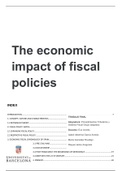The economic
impact of fiscal
policies
INDEX
INTRODUCTION...............................................................................................................................................................3
TRABAJO FINAL
1. CONCEPT, NATURE AND CHARACTERISTICS................................................................................................................4
Asignatura: Procedimientos Tributarios y
1.2 KEYNESIAN THEORY...................................................................................................................................................8
Sistema Fiscal Grupo adaptado
2. FISCAL POLICY: RATES................................................................................................................................................11
Docente: Eva Andrés
2.1 EXPANSIVE FISCAL POLICY.......................................................................................................................................11
Isabel Albertina García Anstiss
2.2 RESTRICTIVE FISCAL POLICY.....................................................................................................................................15
3. ECONOMIC FISCAL CHRONOLOGY OF SPAIN.............................................................................................................17
María González Rivodigo
3.1 PRE CIVIL WAR............................................................................................................17
Raquel Jaime Aragonés
3.2 DICTATORSHIP............................................................................................................18
Isabel Albertina Gracia Anstiss
3.3 POST-FRANCOISM: THE BEGINNINGS OF DEMOCRACY..............................................19
3.4 DEEP INTO THE 21 ST CENTURY..................................................................................21
4. PRESENT........................................................................................................................26
,4.1 LATEST NEWS AFTER THE SANITARY CRISIS............................................................................................................29
5. COMPARISON WITH OTHER TERRITORIES.................................................................................................................33
5.1 INSIDE EUROPE........................................................................................................................................................33
GERMANY...................................................................................................................................................................... 35
ITALY.............................................................................................................................................................................. 35
5.2 USA.......................................................................................................................................................................... 36
CONCLUSION................................................................................................................................................................. 38
BIBLIOGRAPHY...............................................................................................................................................................40
LEGISLATION..................................................................................................................................................................41
WEBGRAPHY..................................................................................................................................................................48
La Moncloa: España remite a la Comisión Europea el Programa de Estabilidad y el Plan Nacional de Reformas. En
línea: https://www.lamoncloa.gob.es/serviciosdeprensa/notasprensa/asuntoseconomicos/Paginas/
2020/010520programa-estabilida.aspx.........................................................................................................................48
La Moncloa. Consejo de Ministros. Referencia. 29 de enero de 2010. En línea:
<https://www.lamoncloa.gob.es/consejodeministros/referencias/documents/2010/refc20100129.pdf>..................48
La Moncloa. Programa de consolidación fiscal para reducir el déficit público al 3% en 2013. 29 de enero de 2010. En
línea: <https://www.lamoncloa.gob.es/paginas/archivo/290110-enlacedeficit.aspx>.................................................48
International Monetary Fund. Qué es el PIB: vuelta a lo esencial. Wala’a El Barasse (Communications Department
IMF), 26 de octubre de 2017. En línea: <https://www.imf.org/external/mmedia/view.aspx?vid=5625789584001>.. .48
International Monetary Fund. ¿Qué es la economía keynesiana? Sarwat Jahan, Ahmed Saber Mahmud y Chris
Papageorgiou, septiembre de 2014. En línea:
<https://www.imf.org/external/pubs/ft/fandd/spa/2014/09/pdf/basics.pdf>............................................................48
ICO Instituto de Crédito Oficial. Líneas Avales COVID-19. En línea: <https://www.ico.es/web/ico/linea-avales-covid-
19>................................................................................................................................................................................ 49
ICEX España Exportación e Inversiones. En línea:
<https://www.icex.es/icex/es/navegacion-principal/que-es-icex/index.html>............................................................49
El País. Trump logra aprobar la mayor bajada de impuestos en tres décadas. Washington: Amanda Mars, 20 de
diciembre de 2017. En línea: <https://elpais.com/internacional/2017/12/20/actualidad/1513749408_053320.html>.
...................................................................................................................................................................................... 49
2
,INTRODUCTION
The aim of this paper is to study the economic impact of fiscal policies. Economic policies are the
set of action plans used and implemented by the State Government to stimulate the economy of
the state. Within economic policies, fiscal policy is the branch that is responsible for taking action
on economic policies. Keynesian theory will also be taken into account. Furthermore, this paper
analyses the economic impact of fiscal policies during the coronavirus crisis due to the importance
this event is currently having on the economy.
There are two different types of fiscal policies explained in this paper. The first type are expansive
fiscal policies that consist in stimulating aggregate demand through two channels: government
spending and investment in certain sectors of the economy, and tax reduction. The second type
are restrictive fiscal policies applied when price inflation occurs, that is with the increase in prices,
purchasing power is reduced as more money is needed to purchase the same goods or services.
Consequently this means that money loses value.
In addition, the paper includes a chronology of fiscal policies since before the civil war in Spain to
explain what brought us to the current economic times, and to understand the economic
management of the coronavirus crisis, reinforced with references to legislation and jurisprudence.
Moreover, this paper provides a comparison with other territories of the European Union and the
United States of America to help understand the global importance of the topic at hand.
3
, 1. CONCEPT, NATURE AND CHARACTERISTICS
Economic policies are the set of instruments or action plans used and implemented by the State
Government to stimulate the economy of the state. Within economic policies, fiscal policy is the
branch that is responsible, through the control of expenditure and income, for achieving economic
stability. Governments set their fiscal policies, therefore, by drawing up state budgets.
Consequently, it could be said that the nature of fiscal policy is to stabilise the economy by
implementing a series of measures that stimulate economic sectors which are stagnant, or that
seek to curb those that produce a negative imbalance.
It takes into account not only the volume of expenditure and revenue but also what that
expenditure is spent on and how revenue (taxes) is collected.
Control of expenditure and revenue is carried out to meet macroeconomic objectives, which are:
To increase the growth of GDP1, it is important that GDP grows, since, as established by
the IMF2, it is the indicator obtained by adding up the value of the goods and services of a
country or by adding up the total income over one year of the country. Therefore, the more
a country produces (the higher the GDP), the better a country's situation will be 3.
To keep unemployment low and stimulate employment, employment is the main source of
income for the population, so if more people do not have jobs, there will be more people
that may not meet their basic needs and will need help or financial benefits and who may
even be at risk of social exclusion or poverty.
To stabilise prices, this is essentially about avoiding inflation, because if prices
rise, people cannot buy as many goods and services for the same price as before inflation,
and would spend more.
To stabilise the budget of the state, means achieving a balance between
income and expenditure of the state, so that the state can invest in services for the
population and do not have to resort to ways of obtaining money that would put the state in
1
Gross domestic product
2
International Monetary Fund
3
https://www.imf.org/external/mmedia/view.aspx?vid=5625789584001
4




